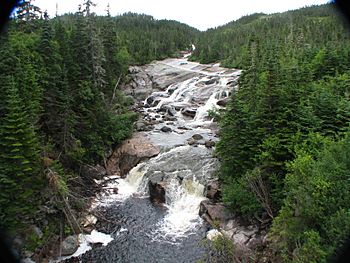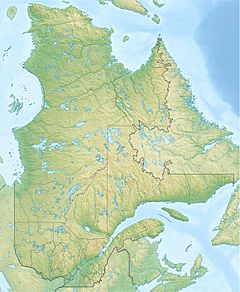Sault Plat River facts for kids
Quick facts for kids Sault Plat River |
|
|---|---|

Geological site of the Rivière-du-Sault Plat
|
|
| Other name(s) | Rivière du Sault Plat |
| Country | Canada |
| Province | Quebec |
| Region | Côte-Nord |
| RCM | Minganie |
| Physical characteristics | |
| Main source | 244 metres (801 ft) |
| 2nd source | Lake Delaunay 148 metres (486 ft) |
| River mouth | Gulf of Saint Lawrence 0 metres (0 ft) 50°17′34″N 65°26′35″W / 50.292778°N 65.443056°W |
| Length | 11.9 kilometres (7.4 mi) |
| Basin features | |
| Basin size | 93.1 square kilometres (35.9 sq mi) |
| Tributaries |
|
The Sault Plat River (also known as Rivière du Sault Plat in French) is a river in Quebec, Canada. It flows through the area of Rivière-au-Tonnerre in the Minganie Regional County Municipality. This river is part of the Côte-Nord region and eventually empties into the Gulf of Saint Lawrence.
The Sault Plat River is famous for showing clear signs of ancient glaciers. These glaciers carved huge ridges and grooves into the bedrock. You can even see a part of the river flowing over these cool rock formations from Quebec Route 138.
Contents
Where is the Sault Plat River Located?
The Sault Plat River begins at Lake Delaunay. This lake is 148 metres (486 ft) above sea level. From there, the river flows south until it reaches the Gulf of Saint Lawrence. Lake Delaunay is surrounded by mountains and gets water from nine other lakes and streams. It also receives water from Grace and Boutereau lakes.
Starting Point of the River
The beginning of the Sault Plat River at Lake Delaunay is:
- About 69.7 kilometres (43.3 mi) northeast of downtown Sept-Îles.
- About 9.6 kilometres (6.0 mi) north of where the Sault Plat River meets the sea.
- About 48.9 kilometres (30.4 mi) southwest of the center of Rivière-au-Tonnerre village.
How the River Flows
From Lake Delaunay, the Sault Plat River flows for 11.9 kilometres (7.4 mi). It drops 148 metres (486 ft) in height along its path. Here's how it flows:
- It travels 3.2 kilometres (2.0 mi) southeast, widening for 0.6 kilometres (0.37 mi).
- It then crosses Tête de Loon lake for 2.1 kilometres (1.3 mi). This lake is 145 metres (476 ft) high.
- The river turns south in the middle of the lake, going around a peninsula.
- Next, it flows 2.6 kilometres (1.6 mi) south, crossing Lac Plat (0.6 kilometres (0.37 mi) long, 140 metres (460 ft) high).
- It reaches a bend where water from other lakes joins it.
- Finally, it flows 6.1 kilometres (3.8 mi) south, collecting three more streams.
- In its last 1.4 kilometres (0.87 mi), it goes down the mountain and under the Quebec Route 138 bridge before reaching its mouth.
The River's End Point
The river ends in the municipality of Rivière-au-Tonnerre. This spot is:
- 47.2 kilometres (29.3 mi) southwest of Rivière-au-Tonnerre village.
- 83.4 kilometres (51.8 mi) northeast of downtown Sept-Îles.
- 197 kilometres (122 mi) southwest of Havre-Saint-Pierre village.
The River's Area
The Sault Plat River's basin, which is the land area that drains into the river, is long and narrow. It stretches 27 kilometres (17 mi) from north-northwest to south-southeast. Its widest part is 5 kilometres (3.1 mi). Most of this basin is in the Minganie Regional County Municipality.
The Name of the River
The Sault Plat River wasn't always on maps. It wasn't shown on maps made by Gustave Rinfret in 1913 or Edgar Rochette in 1927. The name "Rivière du Sault Plat" first officially appeared on a map in 1969. This was in the Répertoire géographique du Québec, which is a list of geographical names in Quebec. The name was officially recognized on December 5, 1968, by the Commission de toponymie du Québec, which is the organization in charge of place names in Quebec.
What the Land is Like Around the River
The northern part of the Sault Plat River's basin is a hilly area called a piedmont. It slopes down from about 300 metres (980 ft) in the north to 150 metres (490 ft) in the south. This piedmont has rounded, rocky hills, with the highest one reaching 533 metres (1,749 ft). Below this hilly area is a flat coastal plain, about 5 kilometres (3.1 mi) wide. It drops from 150 metres (490 ft) in the north to a steep cliff almost 100 metres (330 ft) high near the sea.
Rocks and Soil
The main rock type in the area is magmatic rock, mostly granite and pegmatite. There's also a wide band of migmatite rock that runs across the middle of the river's basin. A thin layer of glacial till, which is rock and soil left by glaciers, covers the bedrock. On the coastal plain, the ancient Goldthwait Sea left behind deep layers of clay and silt. Later, sandy sediments from river deltas covered these layers.
Amazing Glacial Features
One of the most amazing features of the Sault Plat River are the huge glacial flutes near its mouth. These are long, deep grooves carved into the riverbed by glaciers. You can see them clearly from Quebec Route 138. The Quebec government has even named this part of the river an "exceptional geological site." The river flows over these large flutes and troughs that were dug out by glaciers during the last ice age, about 18,000 years ago. At one point, the ice sheet was 3 kilometres (1.9 mi) thick! As the climate got warmer, the ice slowly melted and moved away. It completely disappeared from central Quebec about 6,500 years ago. These flutes and grooves show the direction the ice flowed.
How the River's Water Works
The streams in the Sault Plat basin follow zig-zag paths. They have straight sections and sharp turns because of cracks in the bedrock. In wider valleys, the streams sometimes curve and loop. The Sault Plat River, including the part above Lake Delaunay, is 24 kilometres (15 mi) long. It drops a total of 244 metres (801 ft) from its highest point to its mouth. The average amount of water flowing out of the river each year is about 3.8 cubic metres per second (130 cu ft/s). This flow changes throughout the year, ranging from 0.8 cubic metres per second (28 cu ft/s) to 9.2 cubic metres per second (320 cu ft/s).
Lakes in the Basin
Lake Delaunay, in the middle of the river's basin, is in an old U-shaped valley carved by glaciers. It is 8 kilometres (5.0 mi) long but narrow, covering 3.96 square kilometres (1.53 sq mi). In the northern part of the basin, Lake Boutereau covers 3.21 square kilometres (1.24 sq mi) and Lake Grace covers 1.34 square kilometres (0.52 sq mi). Both of these lakes have irregular shapes. Overall, lakes and other water bodies cover 12.2% of the basin's area. Wetlands, mostly bogs on the coastal plain, cover 1.63% of the area.
Plants and Animals Around the River
The Matamec weather station, which is 37 kilometres (23 mi) west of the Sault Plat River's mouth, records an average yearly temperature of 1.5 °C (34.7 °F). It also reports an average yearly rainfall of 1,020 millimetres (40 in). The area around the river is part of Quebec's ecological regions known for spruce and moss forests.
Trees and Fish
The forests here are made up of black spruce (Picea mariana) and balsam fir (Abies balsamea) trees. Black spruce trees are more common on the coastal plain. In the hilly piedmont region, you'll find a mix of spruce and fir trees. The only type of fish recorded in the river is the brook trout (Salvelinus fontinalis).
Birds
Many waterfowl, which are birds that live near water, gather on the banks of the southern part of the river. In August 2019, a visitor saw several bird species at the river's mouth. These included the double-crested cormorant (Phalacrocorax auritus), the northern gannet (Morus bassanus), and various types of gulls and ducks.


